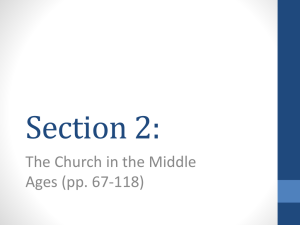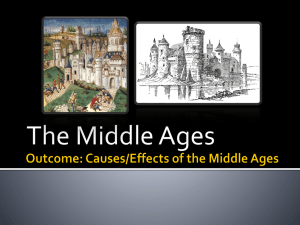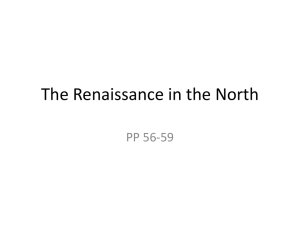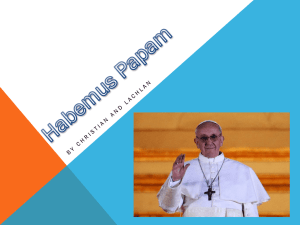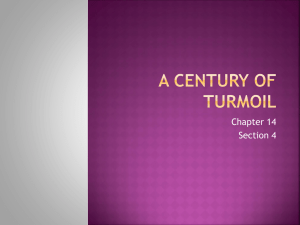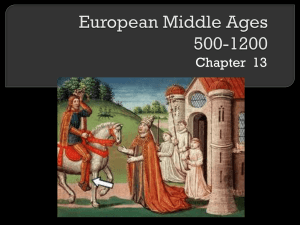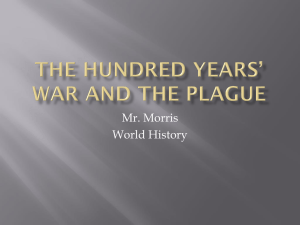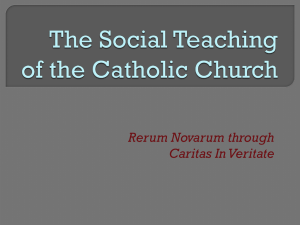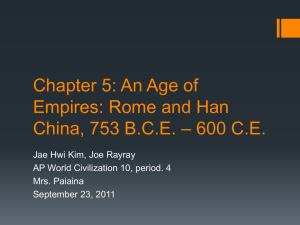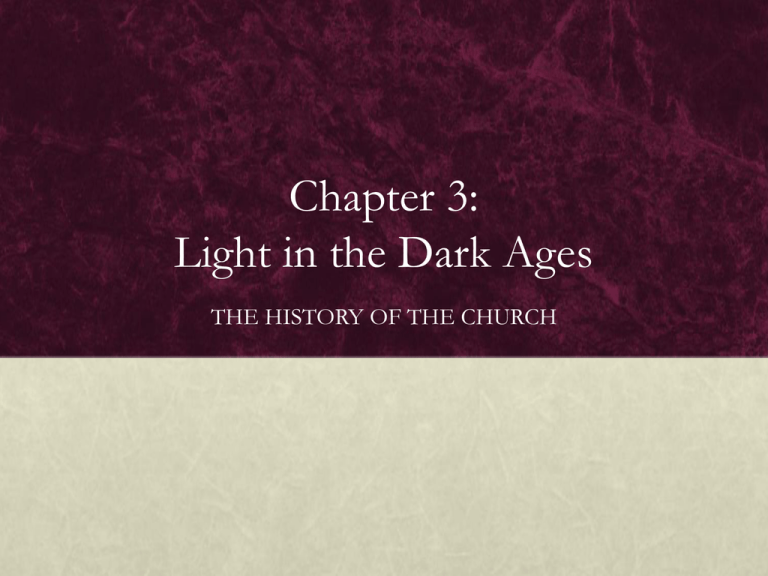
Chapter 3:
Light in the Dark Ages
THE HISTORY OF THE CHURCH
1. The Rise of Monasticism (pp. 94–103)
ANTICIPATORY SET
Identify the relationship between the following triads:
Sex, money, and power
Chastity, poverty, and obedience
1. The Rise of Monasticism (pp. 94–103)
BASIC QUESTIONS
What was the impact of the fall of Rome on the faithful?
What were the causes and effects of monasticism?
What contributions did St. Benedict and his Rule and Pope St. Gregory the Great
make to the preservation and spread of Christianity?
KEY IDEAS
Cities were sacked and depopulated, and culture and economic progress declined.
Monasticism arose out of a desire to leave civilization and devote oneself entirely
to prayer and asceticism in imitation of Christ. Monastics gave new life to the
Faith, brought civilization to the rural areas, preserved classical learning, and
evangelized the Germanic peoples.
St. Benedict’s Rule became the basis of Western monasticism. Pope St. Gregory the
Great was a great spiritual leader who served as a temporal ruler as well.
1. The Rise of Monasticism (pp. 94–103)
GUIDED EXERCISE
Complete a Think/Pair/Share using the following question:
What effect did the fall of Rome have on religious practice?
1. The Rise of Monasticism (pp. 94–103)
FOCUS QUESTIONS
Why is there no clear date for the fall of the western half of the Roman
Empire?
There was more of a gradual collapse than a dramatic, one-day fall. This
disintegration took place over the course of the fifth century.
What did the Romans and the barbarians have in common with respect to
human rights?
Neither had any conception of fundamental human rights, and both cultures
were brutal and violent.
Why did the Romans sometimes invite barbarian tribes to settle along the
frontiers of the empire?
They allowed tribes to settle in exchange for conscripts for the Roman armies
1. The Rise of Monasticism (pp. 94–103)
FOCUS QUESTIONS
What effect did the fall of Rome have on intellectual activity in the West?
It brought about a collapse of intellectual activity in the West, illiteracy becoming the
norm. The study of classical literature and philosophy all but ceased. The Church
remained the only center of intellectual activity.
What effects did the fall of Rome have on economic activity and demographics?
Economic activity fell drastically, crime increased, and the former city-based society
became largely rural, centered on towns and villages.
What effect did the fall of Rome have on the Church’s understanding of her
relationship with the state?
Many Christians and emperors had thought the destiny of the Catholic Church was
intertwined with that of the empire. The collapse of Rome and the western half of that
empire prompted Christians to understand the Church was not wedded to the empire and
1. The Rise of Monasticism (pp. 94–103)
FOCUS QUESTIONS
What was the Germanization of the Roman legions?
It refers to the process by which an increasing percentage of the soldiers in the
Roman military was comprised of people from Germanic tribes.
What does the idea of waves of invaders mean with respect to the
Germanic tribes?
One conquering Germanic tribe would be conquered by another Germanic tribe
later.
Who were the Franks?
They were a Germanic people who settled in Gaul (modern-day France), the
ancestors of the modern French. This was the first Germanic tribe to convert to
orthodox (as opposed to Arian) Christianity.
1. The Rise of Monasticism (pp. 94–103)
FOCUS QUESTIONS
Which was the most successful Germanic tribe?
The Vandals were most successful.
Who was the Apostle to the Goths?
Ulphilas, the Cappadocian who translated the Scriptures into Gothic,
enlightened the Goths.
What religion did the barbarian hordes profess?
To the extent they were not still pagan, most were Arian Christians.
1. The Rise of Monasticism (pp. 94–103)
FOCUS QUESTIONS
What is the origin of the Huns?
It is not known exactly, but they swept westward from Central Asia.
What was the character of Attila the Hun, and why did he not
attack Rome?
Attila was a ruthless leader who was also tremendously brave in battle, a
skilled diplomat, and a keen military strategist. After Pope St. Leo the
Great went out to meet him, Attila withdrew from the Italian Peninsula; it
is not known why he did not sack Rome.
1. The Rise of Monasticism (pp. 94–103)
FOCUS QUESTIONS
What did the Germanic invasions reveal to the Church about her universality?
An increasing number of Christians realized the Church is intended for everyone; the
Germanic tribes needed to be evangelized as the Romans had previously.
How was the Germanic character different from the Greco-Roman character?
The Germanic peoples were less philosophically and theologically inclined, and they
placed less emphasis on order, culture, organization, and law.
To evangelize the Germanic peoples, what was the Church willing to do, and
what was she unwilling to do?
The Church was willing to discard Roman culture without changing the doctrines of
the Faith; she was unwilling the change the Deposit of Faith for any reason.
1. The Rise of Monasticism (pp. 94–103)
GUIDED EXERCISE
Complete a Think/Pair/Share using the following question:
To what extent had Christianity penetrated the mentality of the Germanic tribes by
the end of the fifth century?
1. The Rise of Monasticism (pp. 94–103)
GUIDED EXERCISE
Brainstorm reactions that Italian Christians of the fifth century might
have had toward the invasions (cf. p. 98).
1. The Rise of Monasticism (pp. 94–103)
GRAPHIC ORGANIZER
Work with a partner to complete the following table about the barbarian
invasions of the fourth and fifth centuries (cf. p. 99).
1. The Rise of Monasticism (pp. 94–103)
1. The Rise of Monasticism (pp. 94–103)
FOCUS QUESTIONS
What is monasticism?
It is a way of life in which one leaves the everyday world to live a life of selfdenial and prayer in order to devote his or her whole life to God.
How is Christian monasticism unique?
Though monasticism is practiced by many of the world’s religions, Christian
monasticism is unique because its aim is the imitation of Christ.
What are the two chief types of monasticism?
In eremetical monasticism, a person lives alone as a hermit. In cenobitical
monasticism, a person lives with others in a community.
1. The Rise of Monasticism (pp. 94–103)
GRAPHIC ORGANIZER
Work with a partner to complete the following table on the effects of
monasticism on European culture.
1. The Rise of Monasticism (pp. 94–103)
1. The Rise of Monasticism (pp. 94–103)
FOCUS QUESTIONS
Who founded eremitical monasticism?
Eremitical monasticism was founded in Egypt by Sts. Anthony the Great
and Paul of Thebes.
Who founded cenobitical monasticism?
St. Pachomius, an Egyptian hermit, began cenobitical monasticism
(against his will) after people kept flocking to him.
1. The Rise of Monasticism (pp. 94–103)
GUIDED EXERCISE
Work with a partner to prepare and present a brief oral report using the
following guidelines. Given a short excerpt from the Rule of St. Benedict:
Paraphrase the excerpt.
Interpret how this passage might relate to the life of a monk.
Do you think you could live under this rule? Why or why not?
The Rule can be found on many Web sites.
1. The Rise of Monasticism (pp. 94–103)
FOCUS QUESTIONS
How did St. Gregory the Great spend his life before he became a monk?
St. Gregory was born into an important, noble family, and he held important civil
offices in Rome. After his father died, he sold everything he had and used the money
to found seven monasteries and help the poor.
How was St. Gregory the Great elected Pope, and what was his reaction to this
election?
After Pope Pelagius II had died, St. Gregory was universally acclaimed the new Pope
by the people of Rome. St. Gregory refused this honor initially, but he accepted the
election eventually as God’s will.
Why is Pope St. Gregory I called “the Great”?
He received this title because of missionary successes and his care for the poor.
1. The Rise of Monasticism (pp. 94–103)
GUIDED EXERCISE
Complete a Think/Pair/Share using the following question:
What is the significance of Pope St. Gregory the Great’s use of the title Servus
Servorum Dei for himself and his refusal to acknowledge the title “Ecumenical
Patriarch” for the Patriarch of Constantinople?
1. The Rise of Monasticism (pp. 94–103)
GUIDED EXERCISE
Briefly discuss leadership using the following questions:
What concept of leadership is portrayed by the title Servus Servorum Dei?
How is St. Gregory the Great’s concept of leadership different from the traditional
concept of leadership, for example, that practiced by the pagan Roman emperors?
How is St. Gregory’s concept of leadership especially appropriate for anyone in the
Church who exercises leadership?
1. The Rise of Monasticism (pp. 94–103)
GUIDED EXERCISE
Listen to a sample of Gregorian Chant.
1. The Rise of Monasticism (pp. 94–103)
CLOSURE
Free write for five minutes in response to the following prompt:
Apply the words of Jesus Christ to St. Peter to this period of the Church’s history:
“You are Peter, and on this rock I will build my church, and the powers of death shall
not prevail against it” (Mt 16:18).
1. The Rise of Monasticism (pp. 94–103)
HOMEWORK ASSIGNMENT
Study Questions 1–11 (pp. 138–139)
Practical Exercise 1, 3 (p. 140)
Workbook Questions 1–33
Read “Muhammad (ca. 570–632) and the Koran” through “Spain”
(pp. 105–108)
1. The Rise of Monasticism (pp. 94–103)
ALTERNATIVE ASSESSMENT
Free write for five minutes in response to the following prompt:
Imagine you are a Christian living in a city in the western half of the Roman
Empire and have just heard that a barbarian army is approaching your town.
Write a diary entry about how you feel and what you imagine is about to
happen.
2. Islam and the Conversion of France
and Spain (pp. 104–108)
ANTICIPATORY SET
Discuss the following question:
Imagine you had founded a new religion, believed God wanted everyone to accept it,
and persuaded everyone in your town to believe in it. What are some ways you could
further expand your religion?
2. Islam and the Conversion of
France and Spain (pp. 104–108)
BASIC QUESTIONS
What is the origin of Islam, and what are its chief doctrines?
What key events brought about the conversion of the Franks and Visigoths?
KEY IDEAS
Muhammad founded a new, monotheistic religion based loosely on Judaism
and Christianity.
Under the influence of his wife St. Clotilda, the pagan King Clovis converted
to Catholicism. He founded the Merovingian Dynasty, which became a great
defender of the Church in Europe. After much infighting among the Arian,
Visigoth ruling family—including a prince who married a Merovingian
Catholic princess, converted, and was killed by his own father—King Reccard
converted to Catholicism, which then became the official religion of Spain.
2. Islam and the Conversion of
France and Spain (pp. 104–108)
GUIDED EXERCISE
Search the Internet for information about the Battle of Badr.
2. Islam and the Conversion of
France and Spain (pp. 104–108)
GUIDED EXERCISE
Read silently Matthew 10:34–39, and then discuss the following question:
What did Christ tell his disciples to expect as they convert to Christianity and try to
live the Faith?
2. Islam and the Conversion of
France and Spain (pp. 104–108)
FOCUS QUESTIONS
In what two European locations was the spread of Islam halted?
In the East AD 717 and 740, Emperor Leo III defeated Muslims
attempting to take Constantinople. In the West after Spain had fallen,
Charles Martel stopped the further spread of Islam into Europe at the
Battle of Tours (AD 732).
What likely would have happened had Europeans lost the battles in
the previous question?
Muslims most likely would have conquered all of Europe, invading from
the east and the south.
2. Islam and the Conversion of
France and Spain (pp. 104–108)
FOCUS QUESTIONS
What is the Koran?
According to Muhammad, the Koran is a dictation of the words of the
Archangel Gabriel.
What does the word Islam mean?
It means “submission” and refers to submission to the will of God.
Why are the rise and basic beliefs of Islam important to the study of the
history of the Catholic Church?
Islam is a monotheistic religion whose history is linked with the Arab, Asiatic,
African, and European peoples, and many wars were fought between Christians
and Muslims.
2. Islam and the Conversion of
France and Spain (pp. 104–108)
FOCUS QUESTIONS
What major tasks faced the Church during the evangelization of
Europe?
Monks and bishops not only had to build the institutions of the Church
but also had to raise the moral and cultural level of peoples so they could
be disposed to the Gospel.
In general, what was the initial attitude of Germanic peoples
toward conversion to Christianity?
They were often violent and cruel toward even a family member who
would convert.
2. Islam and the Conversion of
France and Spain (pp. 104–108)
FOCUS QUESTIONS
Why is France called the Church’s Eldest Daughter?
The Franks were the first of the Germanic tribes to convert, and they defended
the Church for centuries.
How were the Franks different from most Germanic tribes?
They were completely pagan, not having had any exposure to Christianity, Arian
or orthodox.
Why had Clovis considered the Christian God ineffective?
Clovis married the beautiful Christian St. Clotilda, who worked to convert him.
Their first child died, and they nearly lost their second. Clovis might have
assumed a powerful God would do better than that.
2. Islam and the Conversion of
France and Spain (pp. 104–108)
GUIDED EXERCISE
Read silently Matthew 10:34–39, and then discuss the following question:
How were Christ’s words fulfilled in the Visigoth rulers of Spain?
2. Islam and the Conversion of
France and Spain (pp. 104–108)
FOCUS QUESTIONS
Why did Clovis convert?
Clovis was facing defeat against the Alemanni and promised the Christian
God, if he won, he would convert and be baptized.
Why did Clovis’ army also convert?
They followed whatever their leader did.
What is the Merovingian Dynasty?
It is comprised of the descendants of Clovis; it is named for Meroveus,
an ancestor of Clovis.
2. Islam and the Conversion of
France and Spain (pp. 104–108)
FOCUS QUESTIONS
How did Catholicism become the official religion of Spain?
After much strife among the ruling family, which was split religiously, King
Reccard ascended to the throne and converted to Catholicism in 587.
When did the Muslim invasions of the Iberian Peninsula begin, and when
was the Reconquista of Spain?
Muslims invaded beginning in 711. The Reconquista was accomplished in 1492.
Who are Mozarabic Christians?
They are the Christians of Spain, centered in Toledo, who lived under Muslims
for almost eight centuries.
2. Islam and the Conversion of
France and Spain (pp. 104–108)
FOCUS QUESTIONS
From whom did Spain believe it had received the Gospel?
It received the Gospel from the Apostles Sts. Paul and James the Greater
(Santiago).
Which tribe conquered Christian Spain, and what was its attitude
toward the Church?
The Arian Visigoths conquered most of the Iberian Peninsula and were
quite intolerant toward the Church.
2. Islam and the Conversion of
France and Spain (pp. 104–108)
HOMEWORK ASSIGNMENT
Study Questions 12–13 (p. 139)
Practical Exercises 2, 4 (p. 140)
Workbook Questions 34–50
Read “St. Patrick: The Apostle of Ireland’” through “St. Bede: The
Father of English History’” (pp. 108–113)
2. Islam and the Conversion of
France and Spain (pp. 104–108)
CLOSURE
Free write for five minutes in response to the following prompt:
Muhammad founded a new, monotheistic religion based loosely on Judaism
and Christianity.
2. Islam and the Conversion of
France and Spain (pp. 104–108)
ALTERNATIVE ASSESSMENT
Free write for five minutes about what you consider the decisive events in
the conversion of Gaul and Spain.
3. The Conversion of Ireland and
England (pp. 108–113)
ANTICIPATORY SET
Complete a Think/Pair/Share using the following question:
How was the Irish Church originally governed?
3. The Conversion of Ireland and
England (pp. 108–113)
BASIC QUESTIONS
What was the Celtic contribution to the preservation of culture, and
how did the Irish evangelize Europe?
How did the conversion of the English people come about?
KEY IDEAS
Celtic monasticism, heavily influenced by the Eastern ascetical
tradition, provided the governance structure for the Church in Ireland,
preserved Greco-Roman learning for Europe, and evangelized
Northern Europe.
Pope St. Gregory the Great sent St. Augustine of Canterbury, a
Benedictine abbot, to England to convert the pagans.
3. The Conversion of Ireland and
England (pp. 108–113)
FOCUS QUESTIONS
St. Patrick is the most famous Irishman. Where was he born, and why
did he spend his teenage and young adult years in Ireland?
St. Patrick was from Roman Britain. He was kidnapped by Irish pirates and
spent his youth as a slave in the northwest of Ireland.
What was the religion of Ireland before St. Patrick’s evangelization?
The Irish were pagan Druids.
Why did St. Patrick decide to return to Ireland?
After he had escaped and returned to his family, a vision called him to return
to Ireland. Soon he began to study for the priesthood.
3. The Conversion of Ireland and
England (pp. 108–113)
FOCUS QUESTIONS
How long did the conversion of Ireland take?
It took about one generation.
Which tradition did Irish monasticism follow: Eastern or Benedictine?
Irish monasticism followed the Eastern tradition, in which monks practiced
severe asceticism, producing spiritual athletes who could endure any hardship.
What made Irish monasteries the intellectual centers of Europe?
The Irish monastic scriptoria and libraries saved a great deal of the GrecoRoman literary tradition, including the ability to read classical Greek.
3. The Conversion of Ireland and
England (pp. 108–113)
FOCUS QUESTIONS
What does St. Columba’s name mean in Latin?
It means “dove.”
Why did St. Columba leave Ireland?
It may have been a penance for having been involved in a civil war.
What king did St. Columba baptize?
He baptized the new Scottish King, which led to the conversion of the
Scots.
3. The Conversion of Ireland and
England (pp. 108–113)
GRAPHIC ORGANIZER
Work with a partner to complete the following table on public and private
penance.
3. The Conversion of Ireland and
England (pp. 108–113)
3. The Conversion of Ireland and
England (pp. 108–113)
FOCUS QUESTIONS
What areas did St. Columbanus evangelize?
He evangelized the northern coast of France and Switzerland.
Given what is known about St. Columbanus’s physical presence, how
does the selection from his Instruction reveal Christ’s transforming
grace?
He could have been a successful despot, yet he wanted to become a man of
peace in the image of the Prince of Peace.
What kind of penance did St. Columbanus and Celtic spirituality
promote?
St. Columbanus promoted the practice of private, frequent, sacramental
3. The Conversion of Ireland and
England (pp. 108–113)
FOCUS QUESTIONS
Who sent St. Augustine of Canterbury to evangelize England?
Pope St. Gregory the Great commissioned his missionary journey personally.
Which Germanic tribes almost wiped out Christianity in England?
The Jutes, Angles, and Saxons nearly annihilated the native Roman Christians.
Celtic missionaries from Ireland had no success converting them.
How did the missionaries react when they heard about the ferocity of
Anglo-Saxons?
St. Augustine of Canterbury asked permission to return to Rome, but Pope
St. Gregory the Great denied this request.
3. The Conversion of Ireland and
England (pp. 108–113)
FOCUS QUESTIONS
How successful was St. Augustine of Canterbury as a missionary?
On Christmas Day 597 alone, some 10,000 Saxons were baptized. Conversions spread
throughout England.
Was the full conversion of England quick or easy?
No; there were six kingdoms in England, and many tended to revert to paganism. Celtic
missionaries played an important role in the ongoing Christianization of England.
What conflict arose within the Church in England, and what was the result?
There were ongoing tensions between the Celtic and Roman traditions. Eventually,
the English accepted the Roman traditions, including Benedictine monasticism over
Celtic monasticism. England became identified especially with the Roman Pontiff.
3. The Conversion of Ireland and
England (pp. 108–113)
FOCUS QUESTIONS
How long did it take for England to become a center of Christian
learning after the beginning of its evangelization?
It took about one century.
What is The Ecclesiastical History of the English People?
Written by St. Bede, it is the first English history. It portrays the Catholic
Church as the center of the development of English culture.
3. The Conversion of Ireland and
England (pp. 108–113)
FOCUS QUESTIONS
What contribution did St. Bede make to the measurement of time?
St. Bede popularized Dionysius Exiguus’s BC/AD system of calculating
years.
Why is St. Bede called Venerable?
Within a century of his death, he was declared Venerable because of his holy
life. Extension: In 1899 Pope Leo XIII named him a Doctor of the Church.
What happened to the Faith in England from the year 800 to 1000?
Though England supplied some of the greatest evangelizers of Europe, the
Church underwent a decline partly because of the ravages of the Vikings.
3. The Conversion of Ireland and
England (pp. 108–113)
CLOSURE
Open-workbook quiz using one or two questions from last night’s
homework.
3. The Conversion of Ireland and
England (pp. 108–113)
HOMEWORK ASSIGNMENT
Study Questions 14–20 (p. 139)
Practical Exercise 5 (p. 140)
Workbook Questions 51–76
Read “The Conversion of Germany and the Low Countries” through
“St. Vladimir: The Apostle of the Russians and Ukrainians’”
(pp. 114–118)
3. The Conversion of Ireland and
England (pp. 108–113)
ALTERNATIVE ASSESSMENT
Write a one-paragraph summary of public vs. private penance using the
completed Graphic Organizer on page 110.
4. The Conversion of Germany and the
Slavs (pp. 114–118)
ANTICIPATORY SET
Discuss how cutting down a single tree was the beginning of the
conversion of the pagan Germans.
4. The Conversion of Germany and
the Slavs (pp. 114–118)
BASIC QUESTIONS
What were St. Boniface’s accomplishments?
Who were Sts. Cyril and Methodius?
KEY IDEAS
Though temperamentally averse to suffering, St. Boniface effected the
conversion of the German people and laid a monastic foundation that
endured for three centuries.
Sts. Cyril and Methodius were brothers who adapted the Faith to Slavic
culture, even inventing a written alphabet so the Slavs could read the
Bible in their own language; unfortunately, many Slavs turned away
from Catholicism because some Popes refused to recognize the use of
the Slavic language for liturgical worship.
4. The Conversion of Germany and
the Slavs (pp. 114–118)
FOCUS QUESTIONS
How long did it take to evangelize Germany and the Low Countries?
It took many centuries. Some tribes had been evangelized before the Fall of
Rome, and others were still being converted in the eleventh century.
What connection exists between the first Anglo-Saxon missionaries
and Rome?
St. Willibrord sought and received papal support for his mission to the Frisians.
What kind of temperament did St. Boniface have in his youth?
St. Boniface was unsteady, timid, and tended toward discouragement and
despair. Nevertheless, he converted the Germans and laid a monastic
foundation that endured for three centuries.
4. The Conversion of Germany and
the Slavs (pp. 114–118)
FOCUS QUESTIONS
What did St. Boniface hope to find when he studied the lives of the
early Christians?
He hoped to discover saints who did not have to suffer. When he could
not, he struggled to be courageous and began to consider ferocious
barbarians his brothers.
How did Pope St. Gregory II show his confidence in the
discouraged Winfrid?
When Winfrid felt like a failure and asked the Pope if he should return to
England, St. Gregory gave Winfrid the new name Boniface, meaning
“doer of good.”
4. The Conversion of Germany and
the Slavs (pp. 114–118)
GUIDED EXERCISE
Complete a Think/Pair/Share using the following question:
Who was St. Boniface’s secular patron, and how did this patron help him?
4. The Conversion of Germany and
the Slavs (pp. 114–118)
GUIDED EXERCISE
Discuss the following question:
What aspects of the Passion of Christ might have appealed to the German people,
and why?
4. The Conversion of Germany and
the Slavs (pp. 114–118)
FOCUS QUESTIONS
What tree did Boniface cut down, and what was the result?
St. Boniface chopped down the Oak of Thor, considered sacred to the
pagan Germans, which proved to the German people that Thor had no
power to hurt him.
What did St. Boniface accomplish during his lifetime?
Before he died a martyr, he converted German pagans, founded
monasteries, established Church structure in Germany, and reformed the
Church in Frankish lands.
4. The Conversion of Germany and
the Slavs (pp. 114–118)
FOCUS QUESTIONS
How were Sts. Cyril and Methodius related?
They were two highly intelligent and well educated brothers who devoted
their entire lives to God and evangelization.
What is Glagolithic script?
St. Cyril invented this alphabet to write the spoken Slavic language.
What is the historical relationship between Poland and the papacy?
Duke Mieszko made Poland a vassal land of the Pope after he had
converted under the influence of his Christian wife, Dubraka.
4. The Conversion of Germany and
the Slavs (pp. 114–118)
FOCUS QUESTIONS
Why did St. Vladimir investigate the major religions of the world?
St. Vladimir thought that allying himself with a major religion might
solidify his rule.
What deal did the Roman (Byzantine) emperor Basil II make with
St. Vladimir?
St. Vladimir wanted to “help” Basil with his army of 6000 Viking
warriors. It was finally agreed that, if St. Vladimir would be baptized, he
could marry Basil’s sister, Anna, and then St. Vladimir’s army would go to
work to quell rebellions within the Roman (Byzantine) Empire.
4. The Conversion of Germany and
the Slavs (pp. 114–118)
FOCUS QUESTIONS
How might people have expected St. Vladimir to have behaved once
his 6000 warriors had entered the Roman (Byzantine) Empire?
Given his previous behavior, it is predictable he would have gone after
them to pillage.
How did St. Vladimir actually behave after he had been baptized?
He changed in a miraculous manner. He dismissed his previous, pagan
wives in favor of the Christian Anna; destroyed idols and shrines, building
churches in their place; established monasteries and Christian schools;
threw banquets for the poor; and made Baptism compulsory.
4. The Conversion of Germany and
the Slavs (pp. 114–118)
GRAPHIC ORGANIZER
Work with a partner to complete the following table about St. Vladimir’s
religious investigations.
4. The Conversion of Germany and
the Slavs (pp. 114–118)
4. The Conversion of Germany and
the Slavs (pp. 114–118)
CLOSURE
Free write for five minutes about the conversion of Germany and the
Low Countries.
4. The Conversion of Germany and
the Slavs (pp. 114–118)
HOMEWORK ASSIGNMENT
Study Questions 21–25 (p. 139)
Practical Exercises 6–7 (p. 140)
Workbook Questions 77–94
Read “Byzantium: The Long View” through “The Feast of the
Triumph of Orthodoxy” (pp. 118–125)
4. The Conversion of Germany and
the Slavs (pp. 114– 118)
ALTERNATIVE ASSESSMENT
Write a paragraph comparing the initial attitudes of St. Augustine of
Canterbury and St. Boniface toward doing missionary work among the
Germanic pagans.
5. The Iconoclastic Controversy (pp. 118–125)
ANTICIPATORY SET
Search the Internet to view several icons. Research and print an icon you
particularly like.
5. The Iconoclastic Controversy (pp. 118–125)
BASIC QUESTIONS
How did Constantinople fare culturally and politically after the Fall of
Rome?
What is iconoclasm, and what lessons can be drawn from it?
KEY IDEAS
Constantinople did not descend into chaos after the Fall of Rome;
rather, it grew superior culturally and politically to the West.
Emperor Leo III—because of abuses regarding the veneration of
icons; the influences of Judaism, Islam, lingering Manichaeism, and
Monophysitism; and for political reasons—ordered their destruction,
which was opposed by the Popes in the West and monks in the East.
St. John of Damascus wrote sublime defenses of icons.
5. The Iconoclastic Controversy (pp. 118–125)
FOCUS QUESTIONS
How did the Christian population of the Roman (Byzantine)
Empire compare with that of Rome and the West?
The Roman (Byzantine) Empire had a much higher Christian population.
What relationship within the Roman (Byzantine) Empire tended to
undermine the authority of the Pope among Eastern Christians?
The intimate relationship between the Roman (Byzantine) emperor and
the Patriarch of Constantinople came to overshadow even that between
the Roman Pontiff and the Patriarch of Constantinople.
5. The Iconoclastic Controversy (pp. 118–125)
GUIDED EXERCISE
Complete a Think/Pair/Share using the following question:
What early disasters did Islam inflict upon the Roman (Byzantine) Empire?
5. The Iconoclastic Controversy (pp. 118–125)
FOCUS QUESTIONS
How long did the Roman Empire endure centered in
Constantinople?
The Roman (Byzantine) Empire lasted more than 1100 years. Extension:
The Roman Republic lasted about 700 years, and then the Roman Empire
(with its capital in Rome and then Constantinople) lasted about 1400
years.
In terms of the Faith, what did the Byzantine Empire enjoy that the
Roman Empire did not?
The Byzantine Empire enjoyed a wholly Christian orientation and
development.
5. The Iconoclastic Controversy (pp. 118–125)
FOCUS QUESTIONS
What political situation in the West tended to increase the sense of the
universality of the Church?
Because of the collapse of the Roman Empire and the absence of strong
political communities with which Christians could identify, the Church tended
to be viewed as an institution that transcended political boundaries and
allegiances.
What feature of the relationship between throne and altar in the East
tended to cause schisms?
The close identification of the Church with the secular authority resulted in
the de facto creation of national churches defined by specific political
boundaries. Burgeoning nationalism often resulted in schisms.
5. The Iconoclastic Controversy (pp. 118–125)
FOCUS QUESTION
What is caesaropapism, and how did it sometimes put a Byzantine
emperor in conflict with a Pope?
Caesaropapism is a political and religious system in which the political
ruler extends his authority into ecclesiastical and theological matters.
Roman (Byzantine) emperors appointed bishops, especially the Patriarch
of Constantinople, and directed the development of liturgical practices,
even recruiting monks, which sometimes put them into conflict with
Popes. Extension: The desire of the secular ruler to control the Church
within his realm was not limited to the East (nor even to Christian rulers,
for that matter); it appeared often in the history of the Western Church as
well, but temporal rule over Church matters never became as solidified as
it was while the Roman Empire had its capital in Constantinople.
5. The Iconoclastic Controversy (pp. 118–125)
GRAPHIC ORGANIZER
Work with a partner to complete the following table on the effects of
Emperor Justinian’s various military campaigns.
5. The Iconoclastic Controversy (pp. 118–125)
5. The Iconoclastic Controversy (pp. 118–125)
FOCUS QUESTIONS
Other than Muslims, who threatened the empire during Justinian’s reign?
His reign was threatened by Persians in the east and Bulgars and Slavs from the north.
What was the importance of the Codex Justinianus?
Emperor Justinian I collected and systematized all of Roman law from its founding in
order to have a uniform rule of law throughout his empire. The resulting Codex
Justinianus was the highest achievement in classical legal scholarship, and it became the
basis of the canon law of the Church and the civil law of many European nations.
What negative influence did Empress Theodora have on her husband?
Emperor Justinian’s beautiful wife convinced him to conspire against the Pope and
replace him with someone she hoped would support her heretical position.
5. The Iconoclastic Controversy (pp. 118–125)
GUIDED EXERCISE
Review the following terms:
Nestorianism
Monophysitism
Hypostatic Union
5. The Iconoclastic Controversy (pp. 118–125)
GUIDED EXERCISE
Mini-lecture: Pope Vigilius and papal infallibility.
5. The Iconoclastic Controversy (pp. 118–125)
GRAPHIC ORGANIZER
Work with a partner to complete the following table to explain five
arguments against the existence and use of icons.
5. The Iconoclastic Controversy (pp. 118–125)
5. The Iconoclastic Controversy (pp. 118–125)
FOCUS QUESTIONS
What is an icon?
It is a stylized, two-dimensional portrayal of Christ, the Blessed Virgin
Mary, one of the saints or angels, or a scene from the Gospels. It can be
painted, a mosaic, or bas-relief.
How is a Christian work of art to be used?
It should be used as an aid to piety or prayer and as a reminder of the
communion of saints.
5. The Iconoclastic Controversy (pp. 118–125)
FOCUS QUESTIONS
What is an iconoclast?
An “icon-breaker” believes it is wrong to have or produce images of Christ and
the saints, most often because it is supposedly against the First Commandment.
What were the motivations of the first iconoclasts?
They wanted to guard against the idolatrous use of icons by destroying them.
Of “adoration” and “honor,” which is appropriate to what beings?
A human being or angel depicted in an icon may legitimately be venerated with
the respect and honor called, in Greek, dulia. God alone is worthy of the true
worship or adoration, called latria.
5. The Iconoclastic Controversy (pp. 118–125)
FOCUS QUESTIONS
Why did Empress Irene want the Ecumenical Council to be held in
Nicæa?
Nicæa was the site of the First Ecumenical Council. Irene and the iconophiles
hoped the bishops in attendance would be reminded of Nicæa I and restore
orthodoxy.
Why could the patriarchs of Alexandria, Antioch, and Jerusalem not attend
the Second Ecumenical Council of Nicæa?
They lived in Muslim-conquered territory; the caliph would not let them attend.
What was the result of the Second Ecumenical Council of Nicæa?
Iconoclasm was condemned as heresy, and East-West communion was restored.
5. The Iconoclastic Controversy (pp. 118–125)
GUIDED EXERCISE
Mini-lecture: Iconoclasm and the development of doctrine.
5. The Iconoclastic Controversy (pp. 118–125)
FOCUS QUESTIONS
What is an iconophile?
An “icon-lover” defends the proper use of icons in Christian worship.
How did St. John of Damascus defend the existence and veneration
of of icons? How was this a defense of all Christian art?
God took on human nature in the Person of Jesus Christ. “He is the
image of the invisible God” (Col 1: 15), which provides implicit
permission to depict Christ’s human form. All such dignified and
respectful depictions are praiseworthy.
5. The Iconoclastic Controversy (pp. 118–125)
FOCUS QUESTIONS
Why did Emperor Constantine V oppress monks?
Most monks were adamantly opposed to iconoclasm. Some 300 monks
were put to death by Constantine V.
What brought about the second period of iconoclasm?
Because many members of the military and the upper echelons of
Byzantine society still adhered to iconoclasm, a series of emperors tried to
revive this heresy to secure their support.
5. The Iconoclastic Controversy (pp. 118–125)
GUIDED EXERCISE
Complete a Think/Pair/Share about the following question:
How did iconoclasm finally come to an end?
5. The Iconoclastic Controversy (pp. 118–125)
CLOSURE
Free write for five minutes in response to the following question:
Why is it not only permissible but praiseworthy to create artistic images of Christ
and the saints?
5. The Iconoclastic Controversy (pp. 118–125)
HOMEWORK ASSIGNMENT
Study Questions 26–31 (p. 139)
Practical Exercise 8 (p. 140)
Workbook Questions 95–123
Read “The Origin of the Carolingian Line” through “Conclusion”
(pp. 126–136)
5. The Iconoclastic Controversy (pp. 118–125)
ALTERNATIVE ASSESSMENT
Write a paragraph about the cultural and spiritual life within the Eastern
half of the Roman Empire after the Fall of Rome.
6. The Carolingians and the Great
Schism (pp. 126–136)
ANTICIPATORY SET
Discuss the following question:
If you had lived in the time of Pope St. Silverius (cf. p. 122), what might you have
wanted in a right relationship between the government and the Church?
6. The Carolingians and the Great
Schism (pp. 126–136)
BASIC QUESTIONS
How was the relationship between the papacy and the Carolingian
Dynasty formed, and what were its effects?
What were the causes of the Great Schism in 1054?
KEY IDEAS
In the West, the Pope established a line of Frankish kings that resulted
in protection of the papacy and the unification of Europe through
Charlemagne.
Numerous differences, misunderstandings, heresies, political intrigues,
and individual sins contributed to divisions between the East and West,
resulting in the Great Schism of 1054.
6. The Carolingians and the Great
Schism (pp. 126–136)
FOCUS QUESTIONS
How did Pepin the Short become the King of France?
He asked the Pope to give him and his heirs kingship over France, which he did.
What did Pope Stephen II’s coronation of Pepin show?
It demonstrated that Pope Stephen and King Pepin believed the Pope could bestow
secular authority on kings.
What were the Papal States, what was unique about them for the Church, and how
long did the Church hold them?
The Papal States were lands around Rome; Pepin had won them from the Lombards and
secured them for the Pope. For the first time in the history of the Church, the Pope
became not just a spiritual leader but also a temporal. This arrangement lasted until 1870,
some 1100 years.
6. The Carolingians and the Great
Schism (pp. 126–136)
FOCUS QUESTIONS
How did Charlemagne show his devotion to the Faith in his public
and private life?
In his public life, Charlemagne modeled civic legislation on the laws of
the Church, tried to reform the clergy, established new dioceses, and
raised funds to support them. His throne was simple and unadorned. In
his private life, Charlemagne lived the Faith, prayed, fasted, and read the
Bible daily.
What was Charlemagne’s relationship with the Popes?
He protected Rome twice from invading Lombards and rescued Pope
Leo III from some Roman noblemen who had imprisoned him.
6. The Carolingians and the Great
Schism (pp. 126–136)
FOCUS QUESTIONS
What did Charlemagne’s coronation mean for the Germanic tribes?
His crowning signified that the Germans were incorporated finally into Roman
civilization.
How did the Roman (Byzantine) emperors view Pope St. Leo III’s coronation
of Charlemagne?
Initially, they were infuriated since they were the emperors of the Roman Empire,
whose capital Constantine had moved from Rome to Constantinople.
What are some examples of Charlemagne’s misapplication of force?
Charlemagne sometimes forced conversions. At one time he ordered the execution of
4000 rebellious pagan Saxons. He applied capital punishment to infringements against
Church practices, including eating meat on Friday. These practices contradict the
6. The Carolingians and the Great
Schism (pp. 126–136)
FOCUS QUESTIONS
What did Charlemagne contribute to learning and art?
Charlemagne emphasized education and artistic excellence and mandated
that every monastery and parish have a school.
What was the result of the Carolingian Renaissance?
The clergy was better educated in classical and biblical texts. This renewed
enthusiasm for the Faith and literature paved the way for renewed
missionary activity.
Who was Alcuin?
A monk and later abbot, Alcuin was the most renowned Latin scholar of
the Carolingian Renaissance.
6. The Carolingians and the Great
Schism (pp. 126–136)
FOCUS QUESTIONS
What are the two basic kinds of Eastern Churches today?
The two basic kinds are Orthodox and Catholic.
What are the similarities between the Eastern Catholic Churches and
Eastern Orthodox Churches?
They share the same liturgies, customs, and practices.
What major difference divided eastern and western Christianity with
respect to the use of the vernacular in their liturgies?
Liturgical worship within the Eastern Churches has always utilized the vernacular
in their liturgies, whereas liturgical worship within the Latin Church was by and
large conducted in Latin.
6. The Carolingians and the Great
Schism (pp. 126–136)
GRAPHIC ORGANIZER
Work with a partner to complete the following table according to the map
“The Empire of Charlemagne” (p. 129).
6. The Carolingians and the Great
Schism (pp. 126–136)
6. The Carolingians and the Great
Schism (pp. 126–136)
GUIDED EXERCISE
Complete a Think/Pair/Share using the following question:
How was the relationship between Charlemagne and the Pope the opposite of
caesaropapism?
6. The Carolingians and the Great
Schism (pp. 126–136)
GRAPHIC ORGANIZER
Work with a partner to complete the following table about emerging
differences between the East and West.
6. The Carolingians and the Great
Schism (pp. 126–136)
6. The Carolingians and the Great
Schism (pp. 126–136)
GUIDED EXERCISE
Make the Sign of the Cross in the method of Eastern Catholics, and then
discuss the following question:
What other differences and similarities do you know between the Western and
Eastern Churches?
6. The Carolingians and the Great
Schism (pp. 126–136)
FOCUS QUESTIONS
From the Western perspective, why was Filioque added to the Nicene
Creed?
It clarified something always believed but left unsaid and its addition prevented a
widespread resurgence of Arianism.
From the Eastern perspective, what was the objection to adding Filioque?
There were two objections: First, the Council Fathers at the Ecumenical Council
of Chalcedon had prohibited changing the Creed. Second, some argued that
Filioque reflected a heretical belief.
When there was a dispute over who the legitimate Patriarch of
Constantinople was, to whom did the emperor and patriarch appeal?
They agreed the Pope had the authority to decide the question.
6. The Carolingians and the Great
Schism (pp. 126–136)
FOCUS QUESTIONS
Why did Patriarch Photius object to Western missionaries in
Bulgaria?
He considered it missionary territory of Eastern Christians.
Of what did Photius accuse the Pope?
Photius charged the Pope with tampering with the Nicene Creed through
the insertion of Filioque to describe the procession of the Holy Spirit.
How was the immediate problem between Emperor Michael III
and Photius solved?
Michael III died and his successor removed Photius as patriarch in an
6. The Carolingians and the Great
Schism (pp. 126–136)
FOCUS QUESTIONS
What did Patriarch Ignatius do in disobedience of the Pope?
Restored as Patriarch of Constantinople, he began to ordain Bulgarian bishops
against the Pope’s order.
How did Patriarch Photius create a schism?
When he was legitimately installed as Patriarch of Constantinople after Ignatius’s
death, he excommunicated the Latin Church for liturgical irregularities and the
insertion of Filioque into the Creed.
What happened to Patriarch Photius?
The new emperor forced him to resign (just as the previous emperor had done),
and a fragile communion was restored between the Eastern and Western
Churches for the next two centuries.
6. The Carolingians and the Great
Schism (pp. 126–136)
FOCUS QUESTIONS
Why did Emperor Constantine IX want to establish peace with the West,
and why was he unsuccessful?
He needed military help against the Normans. Patriarch Michael Cerularius,
however, incited riots against the emperor’s call for reconciliation, threatening
civil war.
How did Patriarch Michael Cerularius respond to Rome’s
excommunication?
Cerularius excommunicated the Western Church for perverting the Faith.
What new titles did the Patriarch of Constantinople receive at this time?
“Ecumenical Patriarch” of the East and “first among equals” of the Eastern
patriarchs.
6. The Carolingians and the Great
Schism (pp. 126–136)
FOCUS QUESTIONS
How did Patriarch Michael Cerularius view the papacy?
He viewed it with disgust.
To what western practices did Patriarch Michael Cerularius object?
He objected to a celibate priesthood, fasting on Saturday, the use of
unleavened bread at Mass, beardless priests, eating meat with blood, and
omitting the Alleluia during Lent.
What did Patriarch Michael Cerularius allow to be done within
churches in Constantinople that followed Western liturgical
practices?
He closed them and allowed their consecrated hosts to be trampled under
foot.
6. The Carolingians and the Great
Schism (pp. 126–136)
HOMEWORK ASSIGNMENT
Study Questions 32–40 (p. 140)
Workbook Questions 124–155
6. The Carolingians and the Great
Schism (pp. 126–136)
CLOSURE
Free write for five minutes about how the establishment of the Papal
States was beneficial to the Church.
6. The Carolingians and the Great
Schism (pp. 126–136)
ALTERNATIVE ASSESSMENT
Discuss what you might have done to avoid the Great Schism had you
been the Pope in 1054.
THE END

